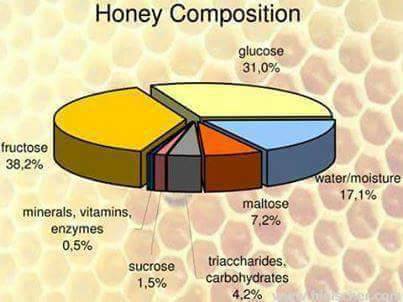Honey is the sweet result of the bees magically transforming the nectar they gather from flowers. Honey is about 80 percent fructose and glucose, and between 17 to 18 percent water.
Maintaining a balance between sugar to water is critical to the quality of honey. Excess water, for example from poor storage, can trigger the spontaneous yeast to ferment, and honey will spoil.
The bees nail this balance instinctually, but it is the improper harvesting and storing of honey that can upset the delicate ratio.

Composition of honey
Honey is composed of sugar (about 76%), water (18%) and other ingredients that make up about 6%. Sugar gives the main characteristics of honey (sweetness), water folows (the liquid), and components that are found in small quantities determine the differences between various types of honey. These differences are the color, aroma and taste.
Sugars
Sugar in honey is not a single species, but consists of three kinds of sugar. These are the fruit sugar (fructose), which has among the highest (41%), grape sugar (glucose), which has about 34% of ordinary sugar (sucrose) which is between 1 and 2%.
The ratio of one type of sugar to other depends of the source, ie flower pasture, and to some extent on enzyme invertase, which breaks down regular sugar in grape and fruit. This enzyme is located in the flower from which the bees collect nectar, but it is also present in the bees body.
Other ingredients The other ingredients include: minerals, proteins, acids and undetermined matter. The ratio of these components varies from one type of honey to another.
Minerals
Minerals has about 3.68%. Although this part of the honey does not make a large amount, minerals in honey raise the value of honey for human consumption.
Honey contains most of the minerals: potassium, chlorine, sulfur, calcium, sodium, phosphorus, magnesium, silicon, iron, manganese and copper.
When the observed mean value, dark types of honey are richer in minerals than lighter. Of course, singles can find a darker species that are poorer than some lighter species.
Proteins
Proteins come in honey from nectar and pollen as a integral parts of plants. Proteins in honey may be in the form of a very complex structure or in the form of simple compounds, ie amino acids.
Acids
Acids are also components of honey. Before it was believed that bees by stomach inserte bee venom into the cell honeycomb with honey and make it so conserved. Given that one of the main components of bee venom is formic acid, it was thought that the honey has a formic acid. Even some people urged to other not to use honey because of that. Studies have shown that they are completely different acids that are composed in honey, mostly apple and lemon acid.
Vitamins
Vitamins in honey has a very modest quantities, insufficient for the needs of the organism. In between are vitamn C and some B complex vitamins (riboflavin, pantothenic acid, pyridoxine, biotin, nicotinic acid).
Essential oils
Essential oils give the characteristic aroma of honey. These substances are very unstable and quickly evaporates by heating honey.
